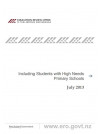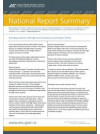This ERO evaluation reports on primary schools' progress in relation to the Government's Success for All policy. Success for All is about getting all schools to demonstrate inclusive practice for students with special needs.
Methodology
Evaluation approach
This evaluation used a matrix which was developed using the findings of the 2010 evaluation to provide indicators for the various levels of inclusion. The matrix is included in Appendix 3.
The current evaluation was designed to collect information on school‑level changes that have taken place since 2009 as a result of Success for All and improvement in individual schools. ERO also collected information on good practice during the course of this evaluation.
ERO gathered and analysed information in response to the following questions:
- How well do schools include students with high needs?
- What issues and challenges exist for schools in enrolling and supporting the inclusion of students with high needs?
- What changes have been made by schools in their inclusive practice since October 2010?
ERO collected documentary evidence from schools, including student enrolment and induction processes, student achievement information, classroom planning and Individual Education Plans (IEPs). Teachers, school leaders and teacher aides were interviewed by ERO at most schools. ERO talked with parents and students at some schools.
Methodological challenges in this evaluation
Two of the three methodological challenges outlined in the 2010 report (ERO, 2010, p. 9) applied to this evaluation as well. These relate to identifying students with high needs and the low numbers of students with high needs at most schools.
As with the previous evaluation, ERO has taken a practical approach to identifying students with high needs. The Special Education Framework defines students with high needs as being those in the top three percent of need for additional support to access the curriculum and learning. These students typically receive support through ORS, the Behaviour Initiative, the Communication Initiative or through the School High Health Needs Fund. While some students receiving ORS funding may always work within Level One of The New Zealand Curriculum others who need mobility or such support can achieve at the same rates as their peers.
ERO discussed with schools which students they considered to be approximately in the top three percent of educational need. Many of these students received some form of additional support, while some did not. There was therefore some slight variance across schools in terms of which students were interpreted as having high needs.
Low numbers of students with high needs
ERO’s analysis was based on what was observed in schools. Reviewers made judgements on the inclusive processes and practices as they related to the high needs students that were currently enrolled at the school. ERO did not make judgements about how well these schools might include future students with high needs.


